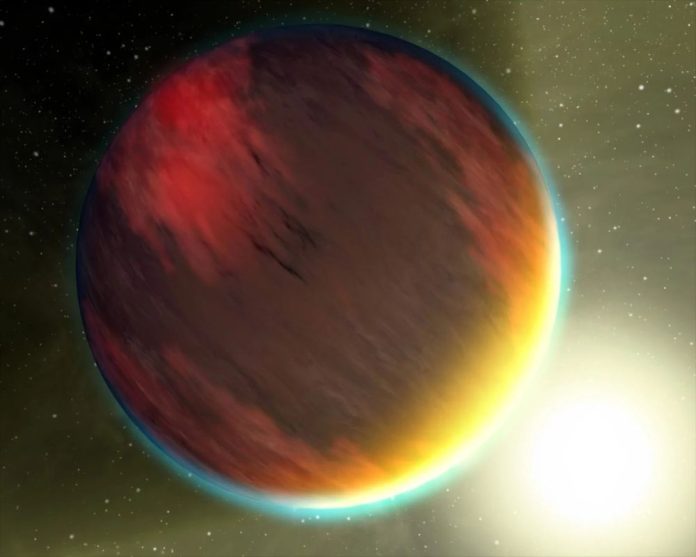
Astronomers have detected a massive, Ultra-Hot Jupiter that’s getting dangerously close to its star.
It’s more massive than Jupiter and orbits its star more quickly than Mercury orbits the Sun. There are only three possible outcomes, and none of them are good for the planet.
The discovery is in new research published in The Astrophysical Journal titled “Orbital Decay of the Ultra-hot Jupiter TOI-2109b: Tidal Constraints and Transit-timing Analysis.”
The lead author is Jaime Alvarado-Montes, a research fellow at Macquarie University in Sydney, Australia.
The exoplanet orbits an F-type star about 870 light-years away. It’s enormous, about five times as massive as Jupiter, yet orbits its star in only 16 hours. That means it’s extremely close to its star.
“Just to put it into context—Mercury’s mass is almost 6,000 times smaller than Jupiter, but it still takes 88 days to orbit our sun.
For a huge gas giant such as TOI-2109b to fully orbit in 16 hours—it tells us that this is a planet located super-close to its star,” said lead author Alvarado-Montes in a press release.
The researchers determined that TOI-2109b’s orbit is slowly yet perceptibly decaying. This is based on 14 years of combined transit timing data from the space telescopes TESS and Cheops, and ground-based data from many telescopes, including the Las Cumbres Observatory Global Telescope network. Those timing measurements, combined with theoretical models, showed that the planet’s orbit is undergoing subtle changes, and that in the next three years its orbital period will shrink by at least 10 seconds. That means the planet has begun a death spiral into its star, and it’s a nearly ideal candidate for further observations and study.
“Since the orbital period of this planet is shorter than the stellar rotation period, TOI-2109b may be an optimal candidate for studying orbital decay,” the authors write. This is because of tidal torquing. Tidal torquing raises tidal bulges on the star, and since the planet is “ahead” of these bulges, it pulls the bulges forward. This transfers angular momentum from the planet’s orbit to the star’s rotation. That makes the star rotate more quickly, and the planet is drawn further inward.
Now that the planet’s orbit is shrinking, there are only three possible outcomes. The planet could cross the Roche limit, the gravitational pull of the star will overpower the exoplanet’s own gravity, and it will be torn apart. Or the planet could plunge directly into its star in a fiery finish. But the third possibility is the most scientifically intriguing: the planet could have its voluminous atmosphere stripped way, leaving only a rocky core.
If that’s what happens, it could explain the existence of some rocky exoplanets. They could be the remnant cores of once massive gas giants.
“This planet and its interesting situation could help us figure out some mysterious astronomical phenomena that so far we really don’t have much evidence to explain,” Dr. Alvarado-Montes says. “It could tell us the story of many other solar systems.”
“TOI-2109b is one of the best candidates for orbital decay among known USP-Js, standing out due to its remarkably short orbital period and the characteristics of its host star,” the researchers explain. There are 12 known stars that host Ultra Short Period Jupiters (USP-J). The star, TOI-2109, has the highest orbital rate of all of them, as well as being the most massive. “All these features may have profound implications for the fate of TOI-2109b,” they write.
However, there are some things that could confound further study.
One rare process that could come into play here is called core-envelope decoupling, and it takes place in stars. In this process, the core and envelope rotate at different rates, and instead of rotating uniformly like a solid body, they essentially become separated from each other. This can happen when material from the planet accretes onto the star. “This could play an important role in the observable signatures of orbital decay,” the researchers explain.
The efficiency of the stellar tide is also unclear. “In the event of orbital decay, the rate at which the period may decrease is determined by the efficiency of the stellar tidal processes that drive the exchange of angular momentum with the planetary orbit,” the authors write. But TOI-2109 is an F-type star, and these processes may not be sufficient in that type of star to lead to greater orbital decay. It can depend on the star’s age, and uncertainties in the star’s age means these processes are not well understood.
The researchers studied two cases, one with a young host star and one with an old host star. They found that the old host star would induce a very fast orbital decay. The reverse was true for the young host star. “Conversely, the planetary companion is significantly more stable against orbital decay if the host star TOI-2109 is younger,” the authors explain.
Unfortunately, some of the data for TOI-2198b is unclear. There are large uncertainties in the mid-transit times, and though the researchers are confident that the planet’s orbit is decaying, it makes predictions challenging. “Future photometric and spectroscopic data will therefore be necessary to further constrain such a scenario,” they write.
The researchers intend to continue monitoring the star and planet for several years. As they watch it spiral to its death, they’ll learn more about these tragic scenarios. Though these types of planets are very rare, with an occurrence rate of only ~0.5%, they may hold important lessons.
“From temporary hot Jupiters that only exist for short periods, to hot Jupiters that paradoxically host water in their atmospheres, USP-Js represent perhaps the most extreme planetary systems and thus the insights we gain from studying these systems are likely to have far-reaching implications,” the authors write.
It’s possible that some of the rocky exoplanets we find are just the remnants of these once-giant planets that got too close to their stars.
Written by Evan Gough/Universe Today.



